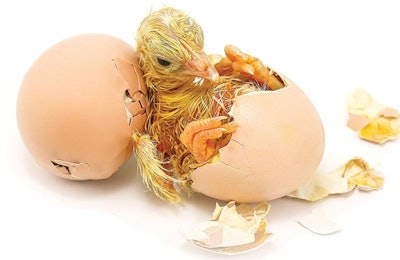
A higher amount of trace minerals fed to breeder birds leads to more, higher quality chicks.
As part of a webinar sponsored by Zinpro Corp. and presented by WATTAgNet, Feed Strategy and WATT Global Media, Dr. Leonardo Linares, global RNS species leader for poultry at Zinpro Corp., shared the results of recent studies concerning the presence of trace minerals in breeder feed and how they correlate to egg shell, embryo and chick quality. The webinar is available to view on-demand for free here.
The role of trace minerals
Linares highlighted eight minerals: Copper, Iron, Zinc, Phosphorus, Manganese, Calcium, Selenium and Iodine. These minerals play a key role in the development of the chick’s embryonic skeleton.
Five of these minerals – copper, iron, zinc, phosphorus, manganese and calcium – are present in the yolk and as the embryo develops inside the shell, they help to transition the skeletal system from cartilage to bone so, after 21 days, the skeleton is strong enough for the chick to hatch.
The embryo takes up almost all the first four minerals from the yolk, but about only 40% of the calcium comes from this source. The rest comes from the shell itself. This underscores the important role a strong bond between the shell membrane and the mammillary layer play in the transmission of minerals to the embryo.
Therefore, it is important to feed high quality minerals to the breeder so they can transfer them to the egg. A lack of the eight minerals can lead to embryo death during incubation.
Supplementation of zinc, manganese and copper
Linares presented the results of two studies that evaluated the role of a Zinpro supplement, Availa ZMC – which contains amino acid complexed zinc, manganese and copper – and how it affects the reproductive performance of breeders and the chicks they hatch.
The supplement functions by helping the embryo take up additional minerals through its blood stream when used by itself and along with sulfates. They help the process of metal ion transportation and amino acid transportation which bring minerals through the enterocyte in the gastrointestinal tract lumen into the blood vessel.
The first study he referenced observed that supplementation of the breeders’ diet with Availa ZMC alone and with sulfates led to higher eggshell percentage, higher eggshell thickness and greater hatchability. This is a significant difference with the hatchability of the fertile egg which ultimately leads to a higher number of chicks per hens housed and a lower percentage of embryo mortality, especially in hens aged 45 to 68 weeks.
The second study he referenced concluded that supplementation of feed with Availa ZMC alone and with sulfates resulted in greater bone thickness.
Overall, the implications of these studies are that feeding Availa ZMC leads to thicker and heavier eggshells, decreased embryo mortality, higher embryo and chick bone quality and increased hatchability.
In terms of return on investment, Linares estimated a total return on investment between five-to-one and 11-to-one. This is based on an estimated three to seven more chicks produced per breeder hen housed. These are higher quality chicks, too.
The blue box
Linares also introduced a new Zinpro product which it calls the BlueBox. This device can candle 15 eggs at once and automatically score the quality of the egg based on its points, or windows, in the egg shell without breaking any eggs.
It sorts eggs into three categories. Score one eggs have little to no points, score two eggs have some points and score three eggs have several points.
Studies conducted in South America show that eggs scored as a three had significantly lower hatchability when laid by a 37 week old flock. When the birds were older, 65 weeks old, there was a linear reduction in hatchability as the score of the egg increased from one to three.
However, Linares said the same studied revealed that feeding the Zinpro supplement could help lead to a lower occurrence of score 3 eggs in a period as short as three weeks. That decline was from 30% to 36%, which means higher hatchability and greater profitability.


















